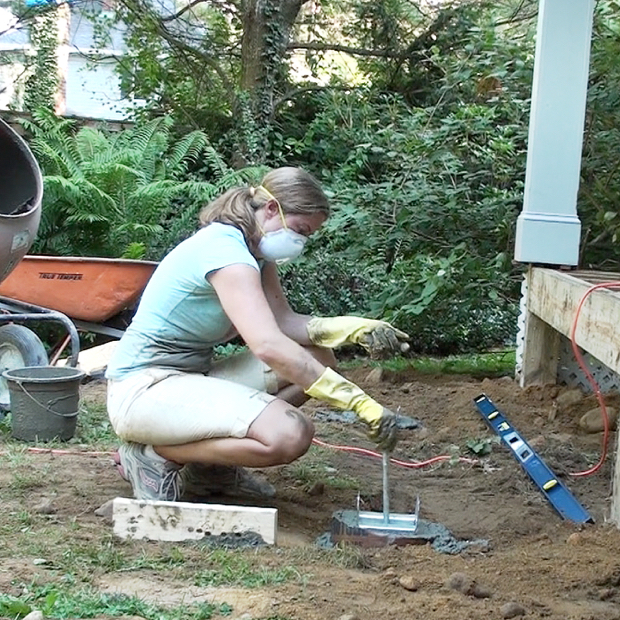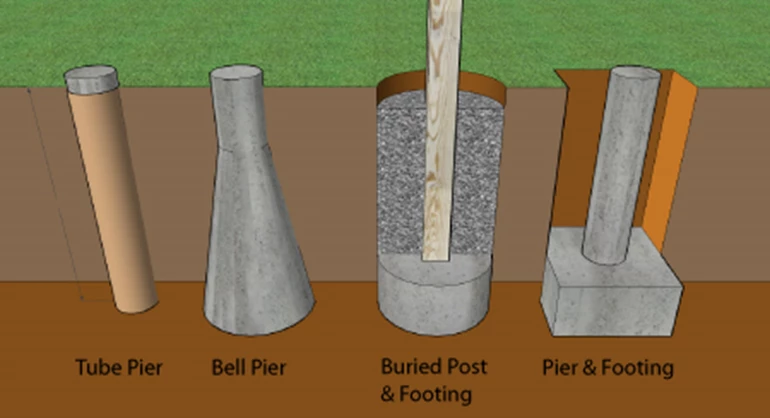Selecting the Right Deck Footings for Stability and Sturdiness
The durability and safety and security of your deck depend heavily on the kind of grounds you select, as they offer the important assistance and security to withstand the examination of time. In this conversation, we will certainly check out the numerous types of deck footings, think about the vital factors to evaluate when making a choice, and dive into the pros and cons of different options.
Sorts Of Deck Grounds
There are numerous sorts of deck footings that can be used, each offering unique advantages and factors to consider. One usual kind of ground is the concrete pier ground. These grounds include a round opening filled with concrete, which offers a strong foundation for the deck articles. Concrete pier grounds are reasonably very easy to mount and provide outstanding security, making them a prominent option for many deck jobs.
An additional sort of ground is the helical stack footing. Helical heaps are steel shafts with helical plates connected to them. These footings are set up by screwing them right into the ground, which produces a secure structure for the deck. Helical stack footings are excellent for areas with tough dirt conditions, as they can be installed in almost any type of soil. If required., they also permit for simple adjustment and progressing of the deck.
Alternatively, some builders go with precast concrete grounds. These footings are made of long lasting concrete and come in various sizes and shapes to suit different deck layouts. Precast concrete footings are convenient to mount and offer a secure base for the deck structure.
Ultimately, an additional choice is the post-in-anchor footing system. This sort of ground includes driving a steel support into the ground and affixing it to the deck message. It supplies flexibility in regards to positioning the deck blog posts and is appropriate for decks with light-weight structures.
When selecting the right kind of deck ground, it is essential to think about variables such as soil conditions, deck tons, and regional building regulations (Deck Footings). Consulting with a specialist contractor or architectural engineer can assist ensure the suitable ground is picked for a stable and safe deck
Aspects to Consider When Choosing Footings
When picking the proper grounds for a deck, it is essential to very carefully take into consideration various aspects such as dirt problems, deck load, and adherence to local building regulations. These elements play a substantial role in ensuring the stability and toughness of the deck framework.
The type of dirt on which the deck will certainly be built figures out the type of footings called for. On the various other hand, decks built on clay or expansive dirts might require grounds that can suit the soil's propensity to increase and agreement.
One more essential element is the deck tons. The weight of the deck, including the products made use of and any kind of prospective live loads such as furnishings or celebrations, should be taken into account when choosing footings. The footings need to be developed to birth the weight of the deck and distribute it evenly to prevent any kind of structural concerns or failures.
Lastly, adherence to local building ordinance is critical. Building ordinance differ from region to area, and it is important to conform with the specific demands set by the regional authorities. Deck Footings. These codes make certain that the deck is constructed safely and fulfills the required criteria for structural honesty and load-bearing capability
Concrete Grounds: Pros and Disadvantages

Concrete footings provide a number of advantages and drawbacks when used as the foundation for a deck. On the positive side, concrete footings provide outstanding stability and resilience.
One more benefit of concrete footings is their flexibility. They can be poured right into various shapes and sizes to accommodate numerous deck styles and arrangements. Concrete grounds can be tailored to fit the certain requirements and needs of the deck structure.
Nevertheless, there are also some drawbacks to using concrete grounds. One significant disadvantage is the price and labor associated with their setup. Concrete footings require excavation and typically require the help of heavy equipment. This can boost the general cost of the deck job and might need specialist assistance.

Helical Piers Vs. Sonotubes: Which Is Much better?
In taking into consideration the structure alternatives for a deck, the contrast between helical piers and sonotubes is crucial in figuring out the remarkable selection. They are twisted into the ground utilizing hydraulic equipment, giving a secure and sturdy foundation for the deck.
When it concerns stability and durability, helical piers have the top hand. The helical plates on the piers produce a strong grip with the dirt, moving or avoiding any activity of the deck. This is particularly advantageous in locations with unsteady or shifting dirt problems. Sonotubes, on the other hand, count entirely on the concrete loading for stability, which might see this here not supply the exact same level of toughness and resistance.
In regards to installation, helical piers are reasonably much easier and faster to mount compared to sonotubes. The hydraulic equipment made use of to twist the piers right into the ground ensures a fast and reliable procedure. Sonotubes, on the various other hand, require digging openings and putting concrete, which can be taxing and labor-intensive.
Additionally, helical piers are a more flexible alternative. If required, they can be made use of in various soil conditions and can be changed or enhanced. Sonotubes, on the various other hand, may click over here require extra assistance, such as rebar, in certain soil conditions or locations with high lots needs.
Selecting the Right Footings for Your Deck's Dimensions
For optimum architectural honesty, it is vital to carefully select the suitable footings that line up with the dimensions of your deck. The dimensions of your deck, including its size, size, and elevation, play a substantial duty in identifying the type and dimension of grounds called for.
When picking grounds for your deck, it is vital to take into consideration the load-bearing capacity of the soil. The weight of the deck, integrated with the weight of any type of furniture or people on it, exerts a substantial pressure on the grounds (Deck Footings). It is critical to pick footings that can properly support this weight without shifting or sinking over time.
The shapes and size of the footings ought to also be taken into consideration. Bigger decks with greater dimensions require bigger footings to provide enough security and support. The form of the grounds, whether they are rounded or square, depends on the design and design of the deck. Additionally, the deepness at which the grounds are mounted must be figured out based on the frost line in your area to avoid any heaving or changing because of freezing temperature levels.
Final Thought
In conclusion, choosing the right deck grounds is critical for guaranteeing security and durability. Elements such as the type of footings, the deck's dimensions, and the pros and cons of different choices must be taken into consideration.
These grounds consist of a round opening filled with concrete, which provides a solid foundation for the deck messages. Concrete pier footings are relatively easy to set up and provide exceptional security, making them a preferred selection for many deck jobs.
Precast concrete footings are hassle-free to mount and provide a stable base for the deck structure.
It provides versatility in terms of positioning the deck read here messages and is suitable for decks with lightweight frameworks.
Concrete grounds use a number of advantages and disadvantages when utilized as the structure for a deck.
Comments on “Deck Footings Demystified: Your Blueprint for a Safe, Long-Lasting Outdoor Sanctuary”